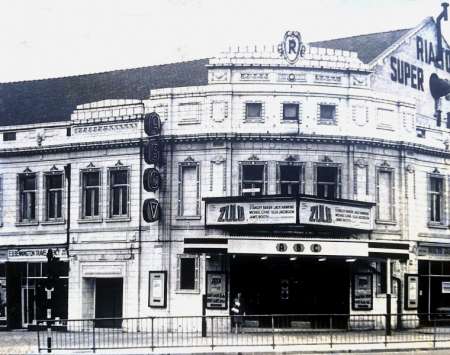Rialto Cinema Bury New Road and Great Cheetham Street West, Broughton
(Always pronounced "Rye-alto" by local residents - presumably to differentiate it from a bridge in Venice that must have cropped up in conversation all too frequently)
Opened October/November 1927. Closed 1963. Demolished 1999
NEW SALFORD HALL: J.L. DIXON OPENS THE RIALTO - Salford's newest super kinema, the New Rialto, opened its doors to the public on Monday evening this week. The new picture theatre has an imposing main entrance and whilst on the left one finds the approach into the hall, there is on the right a very spacious waiting room and lounge and Cosy Corner Tea Room adjoining. Large mirrors in panels on each side of the waiting lounge give it an appearance of greater size than actuality. The kinema building itself has been erected on a steel frame and bricks with a general exterior of white terra cotta. Its seating capacity is around 1400 and there is no balcony. In this respect the hall is one of the largest one-floor theatres in Manchester, Salford and adjoining districts for many miles around. There is another novel feature about the seating arrangements in that the petunia-coloured plush twin seats serve throughout from the cheapest to the dearest seats. The "rake" of the floor of stage is of more than generous dimensions, being one foot in nine, thus each seat is three inches higher than the one in front.
Stage Facilities - As it is intended that this hall shall combine in its programmes high-class vaudeville turns with the pictures, a forty feet wide and twelve feet deep stage has been provided. There are five dressing rooms. A novelty feature in connection with the stage arrangements is the unusual depth of the proscenium arch which is 7 feet. The intention in this connection has been to represent a trumpet mouth and assist the acoustics. Another feature of the stage is that it is situated above a subway that has been built to facilitate the exit of the patrons from the cheaper seats.
The lighting arrangements of the hall generally are of the latest type, and in the hall picturesque lantern holders add a touch of brightness to the general colour scheme of the interior of the hall in which petunia has ben blended as far as possible with gold. Around the whole of the interior of the theatre there is a dark oak panelling at the bottom of the walls and at the entrances a paler shade of oak has been used for the panelling. The cheaper entrance is in Bury New Road but here, as in the main entrance, and for the staircases, marble flooring has been utilised for the steps.
Projection - The auditorium is 130 feet long by 76 feet wide and there is a throw to the screen of 100 feet. Three Kalee machines with LM mirror arcs have been installed in the projection room which is very spacious. The new Rialto will have an orchestra of eight performers, and these will be under the direction of Norvell, the violinist who has previously been identified with the Savoy, Sale. Performances are to be given each day, three times daily, at 2.45, 6.40 and 8.45 and the prices are 6d., 1s., and 1s. 3d.
The architects responsible for this building, which includes nine shops and a billiard room, to be opened shortly, in addition to the theatre are Messrs. Gray and Evans of Liverpool, who have the New Rialto at Liverpool to their credit. [Kinematograph Weekly 27 October 1927 Page 77]
Building Contractors: Messrs Fearnley & Sons Ltd. Constance Works Eccles New Road, Salford. Ref Manchester City News - November 1929. Report on Salford Bus Depot at Weaste lists this building under recent Fearnley contracts
TERRA COTTA PANELS - Above two of the entrances on Great Cheetham Street were ornate terra cotta panels featuring nymphs and musical instruments. E. Caldwell Spruce, the main modeller of Burmantofts of Leeds had originally created these two semi-circular pieces for the Manchester Opera House. Subsequently they had been taken down as part of a re-modelling of the theatre and installed at the Rialto. In Summer 2002 the pieces were held at Willow Pool, an architectural salvage centre at Lymm, with an asking price of £48,000. [Manchester Civic Society. Forum 25, Summer 2002. Page 11]
Operated in various guises as a nightclub, bingo and snooker hall. In 1940s - cinema and dance hall. Later, Jimmy Saville and Alex Higgins launched their careers in the building. In 1996, after being closed for three years, it was purchased by two businessmen who refurbished and reopened the building as a nightclub aimed at the over 25 market. Closed in February 1998 after drainage problems caused foul smells to rise through the dance floor. Owners Carlton Leisure said they hoped to re-open dependent upon costs of repairs, but they never did. August 1998 a mystery fire threatened to destroy the building but caused only smoke damage to the main building. Demolished November/ December 1999 to make way for MacDonalds. [Manchester Evening News 1 December 1999 page 4.]
